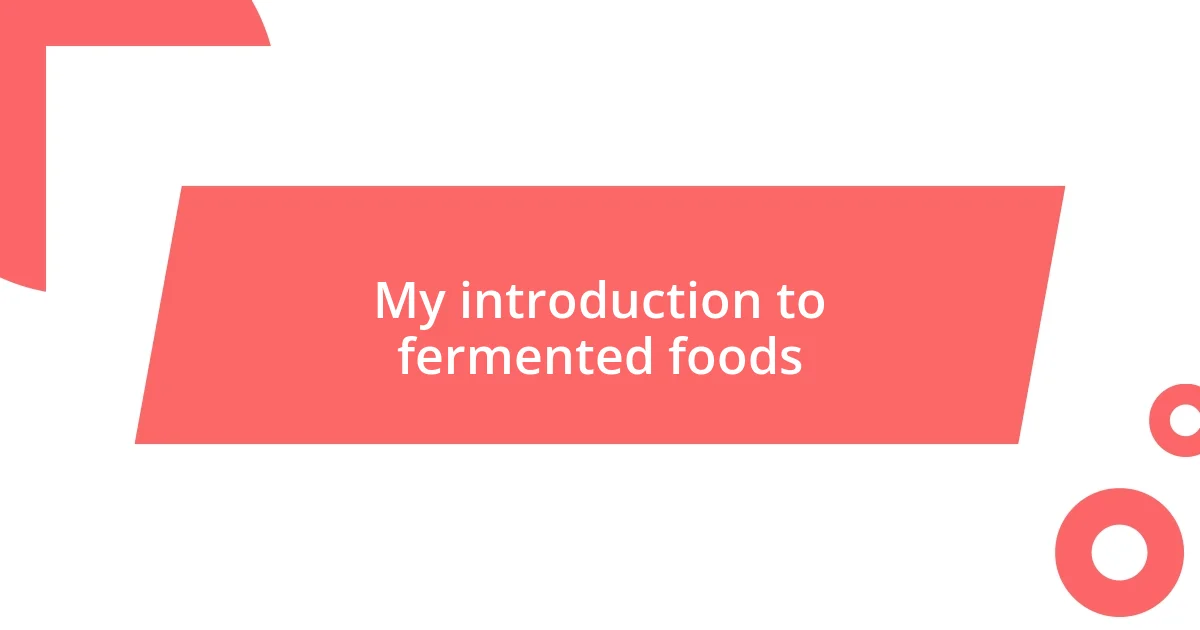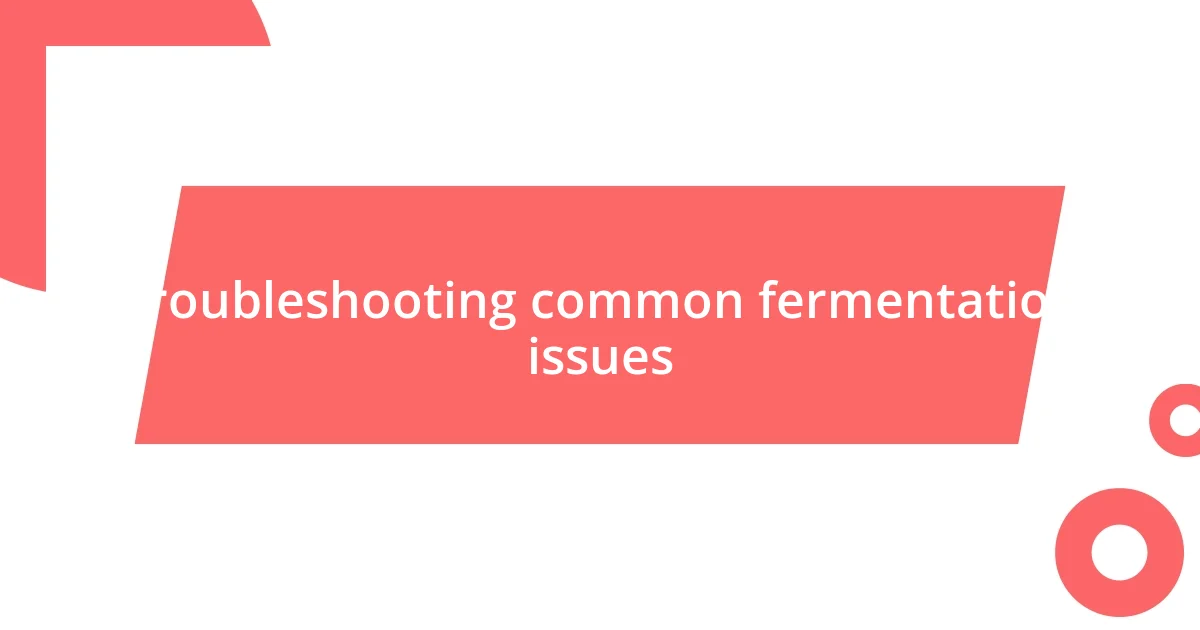Key takeaways:
- The author’s first taste of homemade sauerkraut sparked a curiosity that led them to explore the diverse world of fermented foods.
- Incorporating fermented foods like kimchi and kefir significantly improved the author’s gut health, nutrient absorption, and mood regulation.
- Choosing high-quality ingredients and mastering basic fermentation techniques are crucial for successful home fermentation, leading to flavorful and health-beneficial results.

My introduction to fermented foods
I still remember the first time I tasted homemade sauerkraut at a friend’s house. The vibrant tanginess exploded in my mouth, and as I savored it, I felt an unexpected rush of excitement. Have you ever tried something that sparked a curiosity within you? For me, that moment triggered a journey into the fascinating world of fermented foods.
Several weeks later, after diving deep into fermenting techniques online, I decided to try making my own kimchi. The process was a delightful mix of scents, colors, and textures. I felt a rush of satisfaction as I chopped, seasoned, and sealed everything in jars. Seeing the fermentation bubbles forming gave me a sense of accomplishment—like I was nurturing a little science experiment right in my kitchen.
As I continued exploring, I often asked myself what made these foods so special. Understanding the health benefits was eye-opening. I learned not only about probiotics but also how these foods connect us to culture and tradition. Have you felt that connection to something bigger through food? For me, each bite of kimchi or scoop of yogurt became not just nourishment but also a way to celebrate history and community.

Benefits of fermented foods
The benefits of fermented foods have captured my attention in so many ways. One significant advantage is their role in promoting gut health. When I started incorporating foods like kefir and miso into my diet, I noticed a change in my digestion—things began to feel smoother and more regulated. I often think about how one small addition to my meals could lead to such a powerful shift in my wellbeing.
Another benefit is the enhancement of nutrient absorption. Many fermented foods are rich in vitamins and minerals, but what surprised me is how fermentation can make these nutrients more bioavailable. For instance, after making my first batch of fermented carrots, I marveled at how vibrant they looked and tasted. It was like unlocking the hidden potential of the vegetables! Have you ever experienced that satisfaction of feeling your body truly absorb what you eat? It’s a remarkable feeling that connects you to the food on your plate.
Lastly, fermented foods can contribute to mental health. There’s a growing body of research linking gut health to mood regulation. I remember a particularly stressful week where I turned to my homemade yogurt topped with fresh fruits for comfort. That soothing ritual didn’t just taste good; it felt like a hug for my gut. It’s fascinating how something as simple as food can impact emotions, bringing lightness to tough moments.
| Benefit | Description |
|---|---|
| Gut Health | Supports healthy digestion and can alleviate issues like bloating. |
| Nutrient Absorption | Increases the bioavailability of vitamins and minerals, making nutrients easier for the body to utilize. |
| Mental Health | Affects mood regulation and can provide comfort during stressful times. |

Choosing the right ingredients
Choosing the right ingredients is one of the most crucial steps in my fermentation journey. When I first began, I thought any vegetable or spice would do, but I quickly learned that quality matters. Fresh, organic ingredients not only taste better but also support a more vibrant fermentation process. I remember a time when I used wilted greens and regretted it—my kimchi didn’t have that exhilarating crunch I craved.
Here’s what I focus on when selecting my ingredients:
– Freshness: Choose seasonal and locally-sourced veggies for optimal flavor and nutrients.
– Organic: Whenever possible, go organic to avoid pesticide residues that can hinder fermentation.
– Variety: Experiment with different vegetables and spices to create unique flavor profiles.
– Salt: Use natural salt, like sea salt or Himalayan pink salt, as it promotes healthy fermentation without additives.
– Water: If using water for brines, make sure it’s filtered—chlorinated tap water can interfere with fermentation.
Trust me, taking that extra time to select the right ingredients pays off in the final product. It’s like a symphony; each component works together to create a harmonious flavor. Just thinking about my most successful batch of sauerkraut—crunchy, tangy, and bursting with life—makes me smile. It’s a reminder that the beauty of fermentation starts right where it begins: with the ingredients.

Basic fermentation techniques at home
When I first delved into fermentation, I discovered that understanding fermentation basics was essential. One technique I love is creating a simple brine by dissolving salt in water. This process encourages beneficial bacteria while keeping unwanted ones at bay. I remember the excitement I felt when my first batch of pickles started bubbling—a sure sign that fermentation was in progress!
Another technique I enjoy is the art of “wild fermentation,” which uses natural occurring bacteria. It’s fascinating to think that the environment around us contributes to this process. I once left a jar of chopped veggies out on my counter, and just a few days later, they transformed into a tangy, bubbling delight. Have you ever experienced that thrilling moment of anticipation when you realize something magical is happening in your kitchen? It’s truly rewarding.
Lastly, patience plays a vital role in home fermentation. Once I learned to trust the process, my anxiety about timing melted away. For example, my first batch of fermented radishes took longer than expected, but when I finally tasted them, the flavors were divine. Each time I open a jar of something I’ve fermented at home, I feel a sense of pride, knowing I harnessed those little microbes to create something extraordinary. Isn’t it amazing how a little patience can lead to such delicious results?

Popular fermented foods to try
When it comes to popular fermented foods, you’ll want to start with classic options like kimchi. My first taste of this spicy, tangy Korean dish left me with an unforgettable kick of flavor. I remember how I marveled at the layers of complexity in each bite. You could say that kimchi opened my eyes to the world of fermentation—its zesty balance of cabbage, garlic, and chili made me eager to try making my own version!
Another staple that truly captured my heart is sauerkraut. There’s something special about the deep, tangy notes of properly fermented cabbage. I vividly recall the first time I paired my homemade sauerkraut with a hearty sausage—it was a match made in flavor heaven! The crunch factor was off the charts. Have you ever felt that thrill when a simple food combination becomes a standout dish? That’s precisely what great sauerkraut can do.
If you’re looking for something a bit more adventurous, give kefir a shot. This fermented milk drink is like yogurt’s bubbly cousin, and it’s a probiotic powerhouse. I was initially hesitant—milk fermentation seemed intimidating. But when I finally took the plunge, I found the texture creamy and refreshing, with a pleasantly tangy finish. It feels invigorating to sip something I cultivated on my own. Plus, it’s a fantastic way to give your gut health a boost. Why not take this opportunity to explore the delightful variety of fermented foods out there? Each one brings a unique taste and health benefit to the table!

Troubleshooting common fermentation issues
Fermentation can be a tricky endeavor, and I’ve had my fair share of mishaps. One time, I noticed a fuzzy white film developing on my batch of kombucha, which made my heart sink. It turns out this was a common issue known as mold, often caused by exposure to air. My instinct was to toss the whole batch, but I learned that if it’s just a small spot, you can scrape it off and continue if the rest looks good. Have you ever stood over a jar, debating whether something is salvageable? Trust your instincts, but always prioritize safety!
Another scenario I faced was when my pickles tasted off—even a tad sourer than I expected, and not in a good way. After digging into my notes, I realized I had used too much salt in my brine. Salt is essential for fermentation, but finding the right balance is crucial. I’ve since discovered that a 2-3% salt concentration usually does the trick for veggies. It’s amazing how such a small adjustment can completely change the flavor profile. Has a simple miscalculation ever stood between you and your culinary masterpiece?
Lastly, I once forgot about a batch of fermented carrots tucked away in the back of my fridge, and upon rediscovering them, they were way more tangy than I had planned. This taught me the importance of tasting regularly throughout the fermentation process. Each time I checked, I was rewarded with new layers of flavor that developed over time. Isn’t it thrilling to find a delightful surprise in your kitchen after a little neglect? Regularly checking in lets you gauge when it’s just right, ensuring you can capture the essence of fermentation exactly as you desire.

Incorporating fermented foods in meals
Incorporating fermented foods into meals can elevate even the simplest dishes. I remember the first time I added a dollop of kimchi to my scrambled eggs—what a game changer! The vibrant colors and bold flavors transformed an everyday breakfast into a culinary adventure. Have you ever experienced that moment when one ingredient completely redefines a dish? That’s the kind of excitement I felt!
While experimenting with flavors, I discovered that sauerkraut makes an incredible topping for a hot dog or burger. There’s just something about the crunch and tang that cuts through the richness of the meat, creating a perfect balance. One summer evening, I grilled up some bratwursts and piled them high with my homemade batch. The joy in that first bite was indescribable—it felt as if the flavors were having a celebration on my palate! Could there be a more satisfying way to enjoy these foods?
I’ve also started using kefir in smoothies, which is another delightful way to sneak in those probiotics. The first time I tried blending kefir with frozen berries, I was surprised by how creamy and refreshing the drink turned out! I often wonder how many people overlook such a simple swap in their smoothies. It’s a small change, but it can make a world of difference for both your gut and your taste buds! Each sip is like a nutrient boost that comes with a side of deliciousness.















